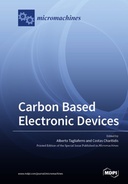Explore

Carbon Based Electronic Devices
Alberto Tagliaferro and Costas Charitidis
2020
0 Ungluers have
Faved this Work
Login to Fave
For more than 50 years, silicon has dominated the electronics industry. However, this growth will come to an end, due to resources limitations. Thus, research developments need to focus to alternative materials, with higher performance and better functionality. Current research achievements have indicated that carbon is one of the promising candidates for its exploitation in the electronics industry. Whereas the physical properties of graphite and diamond have been investigated for many years, the potential for electronic applications of other allotropes of carbon (fullerenes, carbon nanotubes, carbon nanofibres, carbon films, carbon balls and beads, carbon fibers, etc), has only been appreciated relatively recently. Carbon-based materials offer a number of exciting possibilities for new applications of electronic devices, due to their unique thermal and electrical properties. However, the success of carbon-based electronics depends on the rapid progress of the fabrication, doping and manipulation techniques. In this Special Issue, we focus on both insights and advancements in carbon-based electronics. We will also cover various topics ranging from synthesis, functionalisation, and characterisation of carbon-based materials, for their use in electronic devices, including advanced manufacturing techniques, such as 3D printing, ink-jet printing, spray-gun technique, etc.
This book is included in DOAB.
Why read this book? Have your say.
You must be logged in to comment.
Rights Information
Are you the author or publisher of this work? If so, you can claim it as yours by registering as an Unglue.it rights holder.Downloads
This work has been downloaded 250 times via unglue.it ebook links.
- 158 - pdf (CC BY-NC-ND) at Unglue.it.
Keywords
- active-screen plasma sputtering (ASPS) technology
- additive manufacturing
- Aerosol
- Ag nanoparticles
- biochar
- capacitance
- carbon black
- carbon fibers
- carbon fibres
- carbon Inks
- carbon nanofibers
- carbon nanofibres (CNFs)
- carbon nanofillers
- carbon nanotube
- carbon nanotube (CNT)
- carbon nanotubes
- carbon phase transition
- carbon soot
- carbon structure differentiation
- carbon-based material
- carbon-based materials
- contact resistance
- dodecylbenzene sulfonic acid (DBSA) doped polyaniline
- electrical aging
- electrical conductivity
- electron emission
- Electronics
- field emitters
- finite-difference time-domain
- flexible electrode
- Flexible electronics
- flexible wearable devices
- functionalization
- Galinstan
- Graphene
- graphene oxide
- higher performances
- Honey
- humidity sensor
- I-V characteristics
- inkjet printer inks
- ionization sensor array
- Joule heating
- Liquid-Metal
- mechanical impact
- metal nanoparticles
- mobility
- n/a
- NEMS quality
- non-self-sustaining discharge
- NOx
- optoelectronic device
- photosensor
- piezoresistive behavior
- platinum (Pt) and palladium (Pd) nanoparticles
- porous electrode
- pressure sensitivity
- Printing
- quantum electronic activation
- reduced graphene oxide
- ReRAM
- revised Raman characterization
- rheology
- selectivity
- self-powered sensors
- sensors
- silver (Ag)
- solution process
- spray-gun deposition
- spray-on
- supercapacitors
- supercapacitors (SCs)
- TLM
- transparent conducting electrode
Links
DOI: 10.3390/books978-3-03928-233-3Editions


